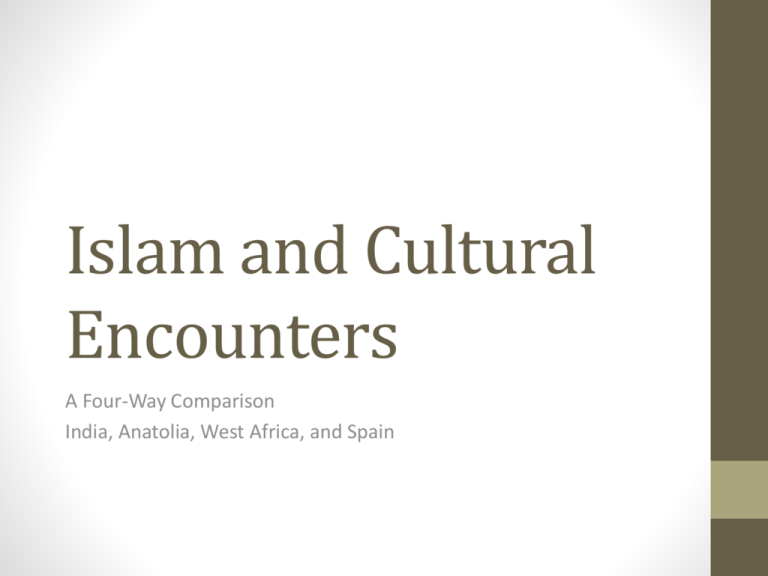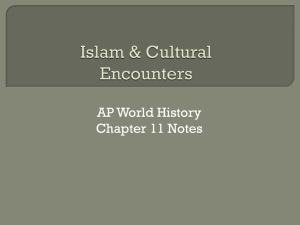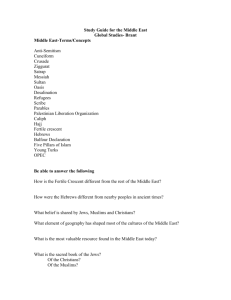Islam and Cultural Encounters
advertisement

Islam and Cultural Encounters A Four-Way Comparison India, Anatolia, West Africa, and Spain Background… • Arab empire had all but disintegrated politically by the tenth century • Last Abbasid caliph killed when Mongols sacked Baghdad in 1258 • But Islamic civilization continued to flourish and expand Case of India… 1. Turkic speaking invaders brought Islam to India 2. Establishment of Turkic and Muslim regimes in India beginning ca. 1000 a. b. At first violent destruction of Hindu and Buddhist temples Sultanate of Delhi (founded 1206) became more systematic 3. Emergence of Muslim communities in India a. b. c. d. e. Buddhists and low-caste Hindus found Islam attractive Newly agrarian people also liked Islam Subjects of Muslim rulers converted lightened tax burden Sufis fit mold of Indian holy men, encouraged conversion-developed “popular Islam” with Hind overlap At height, 20-25% of Indian population converted to Islam • Muslim communities concentrated in NW and Eastern India • Deep Muslim/Hindu cultural divide More India… e. Monotheism vs. polytheism f. equality of believers vs. caste system g. sexual modesty vs. open eroticism 4. Interaction of Hindus and Muslims a. b. c. Many Hindus served Muslim rulers Mystics blurred the line between two religions Sikhism developed in early 16th century; syncretic religion with elements of both Islam and Hinduism • Founded by Guru Nanak d. Muslims remained as a distinctive minority Islam in numbers… Case of Anatolia (Turkey) 1. Turks invaded Anatolia about the same time as India a. b. c. Major destruction at early stages in both places Sufi missionaries were important in both places But in Anatolia by 1500, 90% of population was Muslim, and most spoke Turkish 2. Reasons for the different results in two regions 1. 2. 3. 4. 5. 6. 7. Anatolia had a much smaller population *8 million vs. 48 million in India) Far more Turkic speakers settled in Anatolia Much deeper destruction of Byzantine society in Anatolia Active discrimination against Christians in Anatolia India’s decentralized politics and religion could absorb the shock of invasion better Turkish rulers of Anatolia welcomed converts; fewer social barriers to conversion Sufis replaced Christian institutions in Anatolia More Anatolia… 3. By 1500, the Ottoman Empire was the most powerful Islamic state 4. Turks of Anatolia retained much of their culture after conversion • freer life for women persisted Case of West Africa… 1. Islam came peacefully with traders, not conquest 2. In WA, Islam spread mostly to URBAN areas a. b. Provided links to Muslim trading partners Provided literate officials and religious legitimacy to state 3. By the 16th century, several WA cities were Islamic centers 1. 2. 3. 4. Timbuktu had over 150 Quranic schools and several centers of higher education Libraries had tens of thousands of books Rulers subsidized building of major mosques Arabic became a language of religion, administration, educations, and trade 4. Did not have significant Arab immigration 5. Sufis played little role until 18th century 6. No significant spread into countryside until 19th century 1. Rulers made little effort to impose Islam or rule by Islamic law Timbuktu, Mali…Mosque at Jenne Case for Spain… 1. Arab and Berber forces conquered most of Spain (al-Andalus) in the early 8th century 2. Islam did not overwhelm Christianity there 3. High degree of interaction Between Muslims, Christians, and Jews a. b. Some Christians converted to Islam Some Christians Mozarabs adopted Arabic culture but not religion 4. Religious toleration started to breakdown by late 10th century a. b. c. d. e. Increasing war with Christian states of northern Spain More puritanical forms of Islam entered Spain form North Africa In Muslim-ruled regions, increasing limitations placed on Christians Many Muslims were forced out of Christian conquered regions or kept public practice of their faith Completion of reconquest in 1492 a. 200,000 Jews expelled from Spain Mosque at Cordoba, Spain








